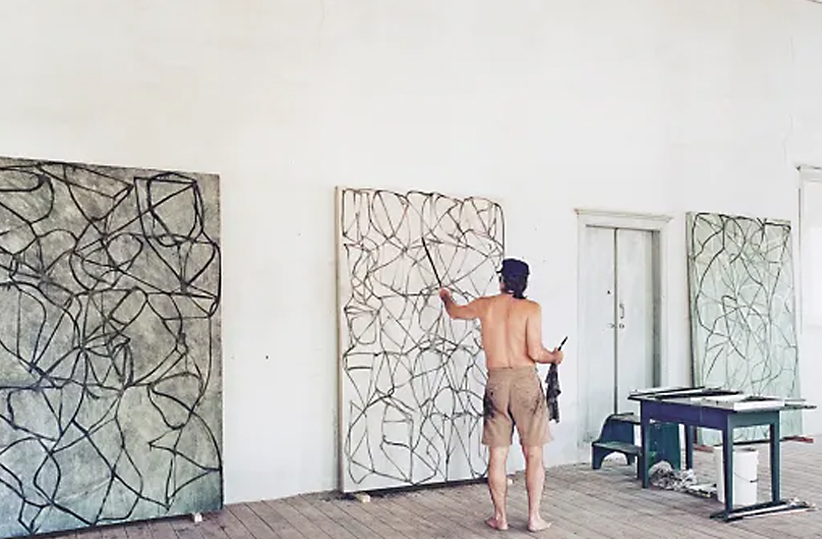
Nestled in the rugged mountains of China, there exists a sanctuary—a sprawling complex crafted by the mysterious artist Tang Song. As I approached his lair for an interview, the scene unfolded like a cinematic tableau, reminiscent of a James Bond film where a mad villain contemplates world-altering plans. This introduction set the stage for an exploration into Tang Song’s life, art, and the tumultuous era of 1980s China.
The Architect of Defiance:
Tang Song’s name is etched in the annals of Chinese contemporary art for his pivotal role in the 1989 exhibition “China Avante-Garde,” a collaboration with artist Xiao Lu that reverberated globally. The interview with Tang was no straightforward conversation; his enigmatic nature emerged as he mirrored questions with rhetorical finesse, making each query seem irrelevant. Yet, his art spoke volumes. The calamitous echoes of 1989 left scars on Tang, a sensitive subject and his own nemesis.
An Artistic Experiment with Life:
Tang’s journey began against the backdrop of the Cultural Revolution, marked by his mother’s tragic suicide when he was just seven. After military service, he immersed himself in the Ink Painting department during a time of fervent experimentation. Rejecting the conventional, Tang explored multi-media installations and performance art. His encounter with Robert Rauschenberg in 1985 left an indelible mark, urging him to build something new for China.
During our interview, Tang shared memories of a time when “there was no such thing as contemporary.” The lack of words to describe the burgeoning artistic movement encapsulated the essence of his early works, a departure from prescribed ink on xuan paper, leaning towards multi-media installations and performance. Action became the mandate for his life and work, with creativity springing from the well of performance.
Nomadic Pursuit of Hope:
Following the symbolic end of the ’80s, Tang embarked on a daring escape, stowing away on a cargo ship bound for Australia. His arrival was met with detention in a refugee camp, yet Tang continued his artistic endeavors, creating installations that defied expectations. The rainbow, witnessed upon emerging from the camp, became a symbol of hope and eternity, recurring in Tang’s later works.
The rainbow, stretching across the sky as Tang emerged into the sunlight, symbolized a beacon of hope and eternity that transcended the hardships he faced. His time in the refugee camp was marked by challenges, but Tang persisted in his artistic pursuits. An installation of five thousand matches, standing with their tips facing up, created a sea of red—a minimal sculpture with myriad implications that required vigilant oversight to prevent any potential fires. Tang’s art, like his character, dared, threatened, and invited simultaneously.
Turmoil and Triumph on Canvas:
Returning to China in 2007, Tang’s nomadic existence continued, with studios in Beijing, Hangzhou, and Shanghai. His colossal canvases, reaching up to thirty meters, bear witness to his desperate and determined actions. Thick coats of paint, applied with mops, reveal the arduous process beneath—a self-referent archaeology of labor, anguish, and transcendence. Each canvas is a testament to Tang’s resilience and refusal to retreat.
During this period, Tang’s canvases became the result of a series of desperate, determined actions. He forcefully worked his surfaces with dense coats of paint, sometimes applied with mops, over a grid or other patterns made of strings. Sometimes he used a power saw to reveal the painting’s self-referent archeology—years of labor, anguish, indecision, disgust, jubilation, transcendence. The sheer thickness and scale of the paintings reveal the energy and physical endurance Tang employed to execute them. Painting is no easy task, capable of exhausting one’s vital essence, yet with each canvas, there are no signs of Tang retreating. Each is presented like a mere occasion in a long history of turmoil rather than a finished work of art.
The Man Behind the Art:
A chance encounter reunited us after years, and Tang believed it was fate that brought us together. His life intertwined with Lao Wang, a partner who guided him towards the light. Tang’s paintings, scarred like the man himself, emanate existential awe. His invitation to arm wrestle, drink, and smoke encapsulates the paradox of Tang—threatening yet dancing, embodying the complexity of his art.
Tang’s paintings, often described by him as a form of courtship and love about liberty, became a reflection of his life. The complexity of his character found resonance in the layers of paint on his canvases. Each stroke and layer seemed to echo the tumultuous journey of an artist navigating life’s absurdities and the futility that often plagued it.
Epilogue:
As Tang Song passed away, Shanghai’s skies were painted with rainbows—a fitting tribute to an artist who perpetually moved towards the unattainable rainbow. His artistic odyssey, a fusion of passion and paint, leaves an indelible mark on China’s contemporary art landscape, inviting us to contemplate the profound intersections of life and creativity. The symbolism of the rainbow, a recurring motif in Tang’s art, encapsulates the essence of his journey—an enduring quest for hope and eternity amidst the complexities of existence.
